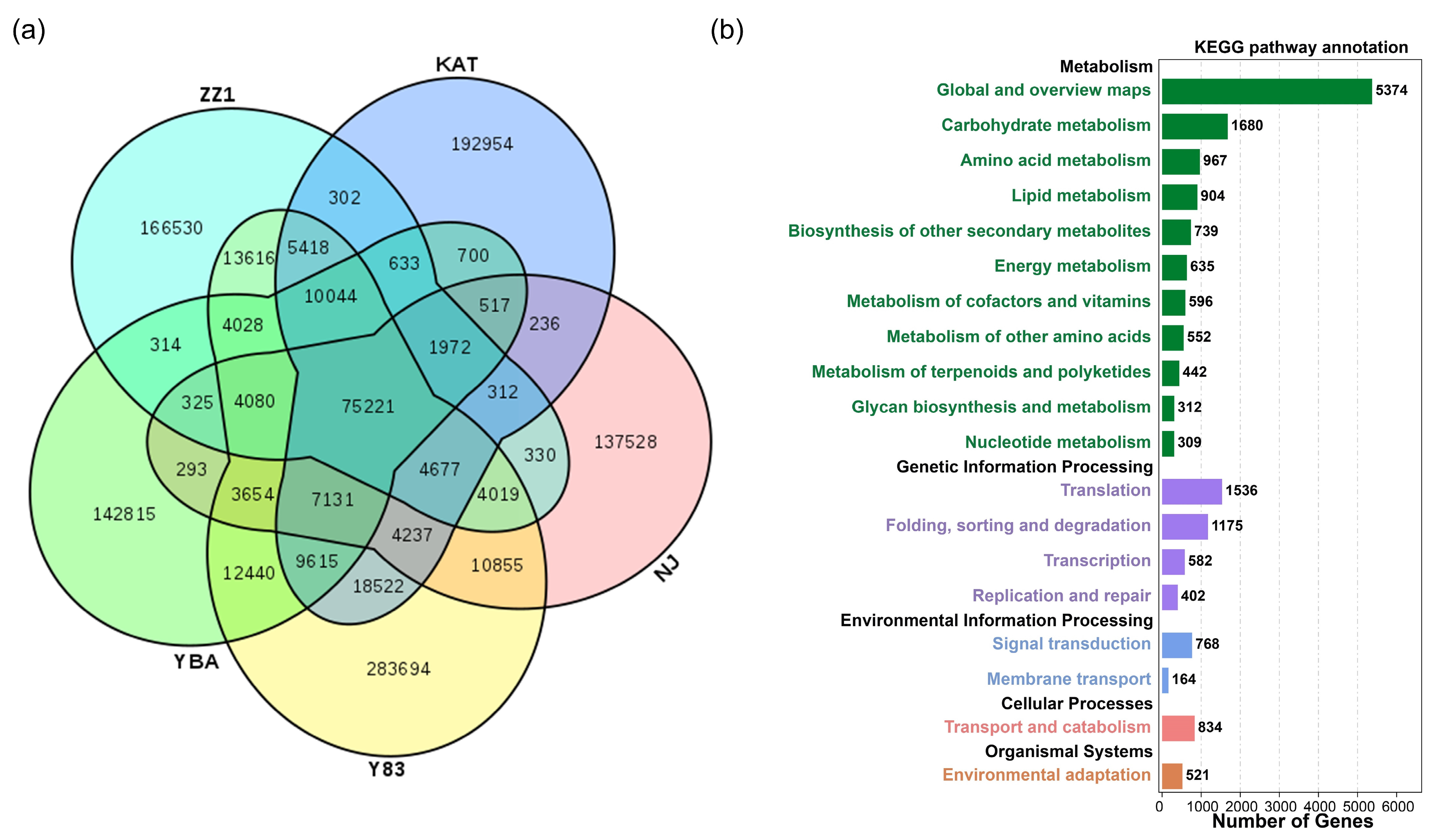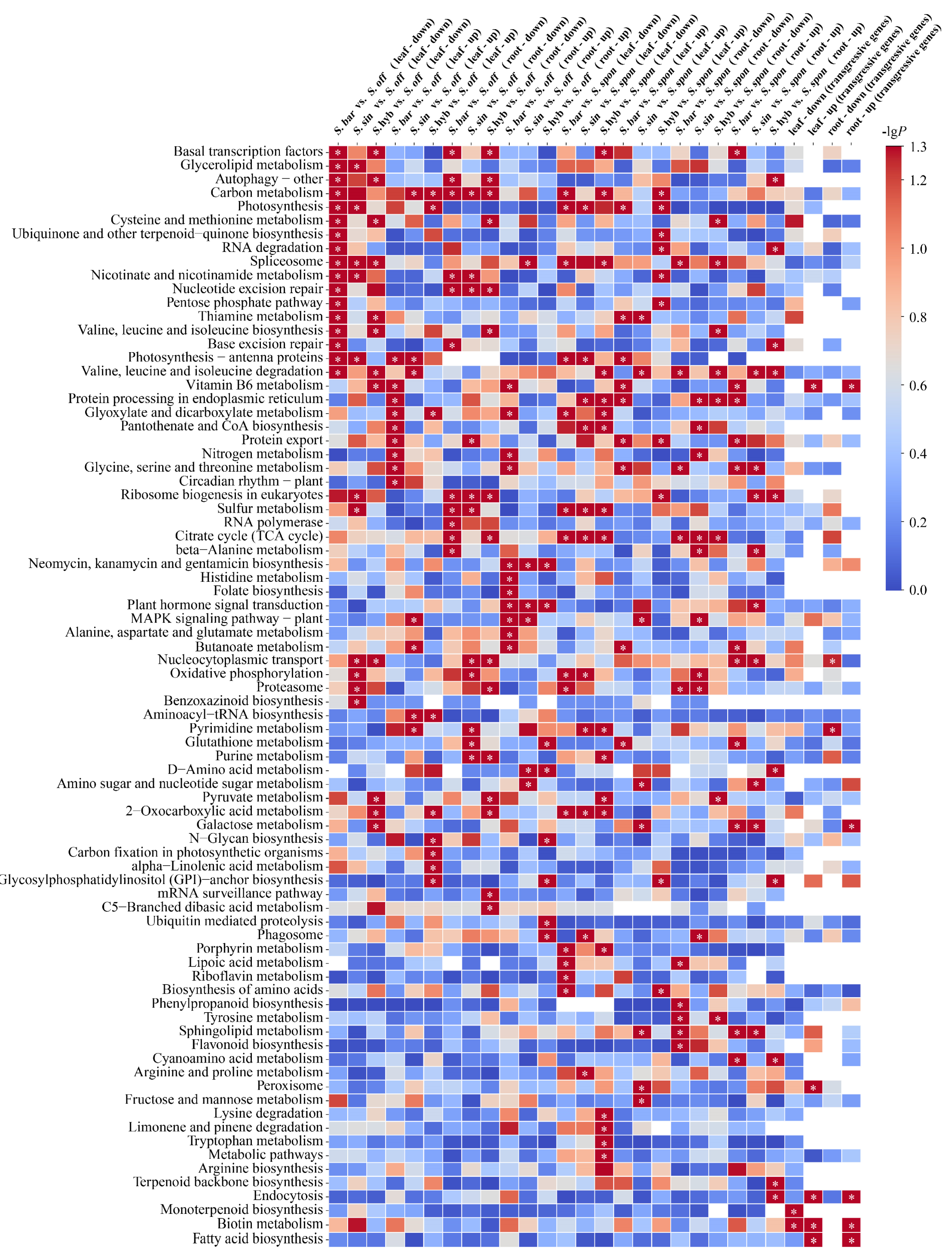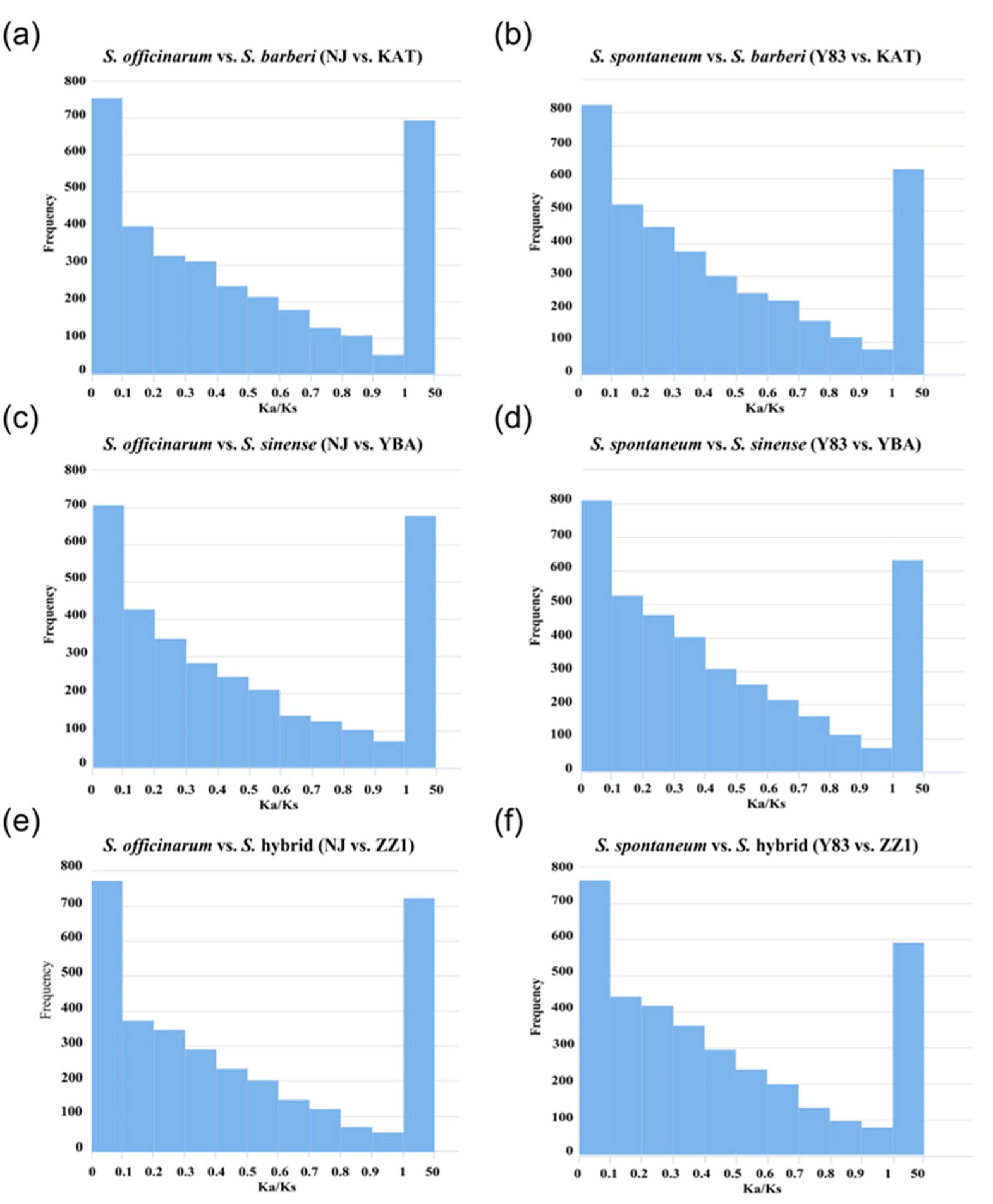Molecular Genetic Mechanisms of Heterosis in Sugarcane Cultivars Using a Comparative Transcriptome Analysis of Hybrids and Ancestral Parents
Abstract
:1. Introduction
2. Materials and Methods
2.1. Plant Material and RNA Sequencing
2.2. Assembly, Construction and Annotation of Transcriptomes
2.3. Differential Expression and KEGG Enrichment Analysis
2.4. Orthologous Analysis and Selection Pressure Analysis
3. Results
3.1. Transcriptomic Data Processing and Assembly
3.2. Shared and Unique Unigenes and Characterization of Specifically Expressed Genes of the Five Sugarcane Transcriptomes
3.3. Differential Gene Expression Analysis of the Five Sugarcane Transcriptomes
3.4. Selection Pressure Analysis
4. Discussion
4.1. Global Alterations in Gene Expression in Hybrid Progeny
4.2. Features of Transgressive Expression of Genes in Hybrids
4.3. Positive Selection of Genes in Subgenomes
5. Conclusions
Supplementary Materials
Author Contributions
Funding
Data Availability Statement
Conflicts of Interest
References
- Wang, K.; Cheng, H.; Han, J.; Esh, A.; Liu, J.; Zhang, Y.; Wang, B. A comprehensive molecular cytogenetic analysis of the genome architecture in modern sugarcane cultivars. Chromosome Res. 2022, 30, 29–41. [Google Scholar] [CrossRef] [PubMed]
- Thomas, B.C.; Pedersen, B.; Freeling, M. Following tetraploidy in an Arabidopsis ancestor, genes were removed preferentially from one homeolog leaving clusters enriched in dose-sensitive genes. Genome Res. 2006, 16, 934–946. [Google Scholar] [CrossRef] [PubMed] [Green Version]
- Comai, L. Genetic and epigenetic interactions in allopolyploid plants. In Plant Gene Silencing; Springer: Berlin/Heidelberg, Germany, 2000; pp. 267–279. [Google Scholar]
- Adams, K.L.; Wendel, J.F. Polyploidy and genome evolution in plants. Curr. Opin. Plant Biol. 2005, 8, 135–141. [Google Scholar] [CrossRef] [PubMed]
- Wu, Y.; Sun, Y.; Wang, X.; Lin, X.; Sun, S.; Shen, K.; Wang, J.; Jiang, T.; Zhong, S.; Xu, C. Transcriptome shock in an interspecific F1 triploid hybrid of Oryza revealed by RNA sequencing. J. Integr. Plant Biol. 2016, 58, 150–164. [Google Scholar] [CrossRef]
- Jackson, S.; Chen, Z.J. Genomic and expression plasticity of polyploidy. Curr. Opin. Plant Biol. 2010, 13, 153–159. [Google Scholar] [CrossRef] [Green Version]
- Grover, C.; Gallagher, J.; Szadkowski, E.; Yoo, M.; Flagel, L.; Wendel, J. Homoeolog expression bias and expression level dominance in allopolyploids. New Phytol. 2012, 196, 966–971. [Google Scholar] [CrossRef]
- Rapp, R.A.; Udall, J.A.; Wendel, J.F. Genomic expression dominance in allopolyploids. BMC Biol. 2009, 7, 18. [Google Scholar] [CrossRef] [Green Version]
- Barreto, F.S.; Pereira, R.J.; Burton, R.S. Hybrid dysfunction and physiological compensation in gene expression. Mol. Biol. Evol. 2015, 32, 613–622. [Google Scholar] [CrossRef] [Green Version]
- Go, A.C.; Civetta, A. Hybrid incompatibilities and transgressive gene expression between two closely related subspecies of Drosophila. Front. Genet. 2020, 11, 599292. [Google Scholar] [CrossRef]
- Fu, J.; Zhang, Y.; Yan, T.; Li, Y.; Jiang, N.; Zhou, Y.; Zhou, Q.; Qin, P.; Fu, C.; Lin, H. Transcriptome profiling of two super hybrid rice provides insights into the genetic basis of heterosis. BMC Plant Biol. 2022, 22, 314. [Google Scholar] [CrossRef]
- Wang, M.; Wang, J. Transcriptome and DNA methylome analyses provide insight into the heterosis in flag leaf of inter-subspecific hybrid rice. Plant Mol. Biol. 2022, 108, 105–125. [Google Scholar] [CrossRef]
- Serba, D.D.; Meng, X.; Schnable, J.; Bashir, E.; Michaud, J.; Prasad, P.V.; Perumal, R. Comparative Transcriptome analysis reveals genetic mechanisms of sugarcane aphid resistance in grain Sorghum. Int. J. Mol. Sci. 2021, 22, 7129. [Google Scholar] [CrossRef]
- Zeng, Z.; Liu, X.; Deng, Q.; Ashraf, U.; Chen, J.; Shen, W. Transcriptome analysis revealed mechanisms involved in improved germination and growth of sugarcane by ultrasonic treatment. Ind. Crops Prod. 2023, 192, 116104. [Google Scholar] [CrossRef]
- Huang, X.; Liang, Y.; Zhang, B.; Song, X.; Li, Y.; Li, C.; Qin, Z.; Li, D.; Wei, J.; Wu, J. Comparative transcriptome analysis reveals potential gene modules associated with cold tolerance in sugarcane (Saccharum officinarum L.). J. Plant Growth Regul. 2022, 41, 2614–2628. [Google Scholar] [CrossRef]
- Vignesh, P.; Mahadevaiah, C.; Parimalan, R.; Valarmathi, R.; Dharshini, S.; Nisha, S.; Suresha, G.; Swathi, S.; Swamy, H.M.; Sreenivasa, V. Comparative de novo transcriptome analysis identifies salinity stress responsive genes and metabolic pathways in sugarcane and its wild relative Erianthus arundinaceus [Retzius] Jeswiet. Sci. Rep. 2021, 11, 24514. [Google Scholar] [CrossRef]
- Chen, S.; Zhou, Y.; Chen, Y.; Gu, J. fastp: An ultra-fast all-in-one FASTQ preprocessor. Bioinformatics 2018, 34, i884–i890. [Google Scholar] [CrossRef]
- Kim, D.; Langmead, B.; Salzberg, S.L. HISAT: A fast spliced aligner with low memory requirements. Nat. Methods 2015, 12, 357–360. [Google Scholar] [CrossRef] [Green Version]
- Haas, B.J.; Papanicolaou, A.; Yassour, M.; Grabherr, M.; Blood, P.D.; Bowden, J.; Couger, M.B.; Eccles, D.; Li, B.; Lieber, M.; et al. De novo transcript sequence reconstruction from RNA-seq using the Trinity platform for reference generation and analysis. Nat. Protoc. 2013, 8, 1494–1512. [Google Scholar] [CrossRef]
- Wu, T.D.; Watanabe, C.K. GMAP: A genomic mapping and alignment program for mRNA and EST sequences. Bioinformatics 2005, 21, 1859–1875. [Google Scholar] [CrossRef] [Green Version]
- Li, W.; Godzik, A. Cd-hit: A fast program for clustering and comparing large sets of protein or nucleotide sequences. Bioinformatics 2006, 22, 1658–1659. [Google Scholar] [CrossRef] [Green Version]
- Simão, F.A.; Waterhouse, R.M.; Ioannidis, P.; Kriventseva, E.V.; Zdobnov, E.M. BUSCO: Assessing genome assembly and annotation completeness with single-copy orthologs. Bioinformatics 2015, 31, 3210–3212. [Google Scholar] [CrossRef] [PubMed] [Green Version]
- Langmead, B.; Salzberg, S.L. Fast gapped-read alignment with Bowtie 2. Nat. Methods 2012, 9, 357–359. [Google Scholar] [CrossRef] [PubMed] [Green Version]
- Patro, R.; Duggal, G.; Love, M.I.; Irizarry, R.A.; Kingsford, C. Salmon provides fast and bias-aware quantification of transcript expression. Nat. Methods 2017, 14, 417–419. [Google Scholar] [CrossRef] [PubMed] [Green Version]
- Robinson, M.D.; McCarthy, D.J.; Smyth, G.K. edgeR: A Bioconductor package for differential expression analysis of digital gene expression data. Bioinformatics 2010, 26, 139–140. [Google Scholar] [CrossRef] [Green Version]
- Ogata, H.; Goto, S.; Sato, K.; Fujibuchi, W.; Bono, H.; Kanehisa, M. KEGG: Kyoto encyclopedia of genes and genomes. Nucleic Acids Res. 2000, 28, 27–30. [Google Scholar]
- Emms, D.M.; Kelly, S. OrthoFinder: Phylogenetic orthology inference for comparative genomics. Genome Biol. 2019, 20, 238. [Google Scholar]
- Bodenhofer, U.; Bonatesta, E.; Horejš-Kainrath, C.; Hochreiter, S. msa: An R package for multiple sequence alignment. Bioinformatics 2015, 31, 3997–3999. [Google Scholar] [CrossRef]
- Stamatakis, A. RAxML version 8: A tool for phylogenetic analysis and post-analysis of large phylogenies. Bioinformatics 2014, 30, 1312–1313. [Google Scholar]
- Wang, D.; Zhang, Y.; Zhang, Z.; Zhu, J.; Yu, J. KaKs_Calculator 2.0: A toolkit incorporating gamma-series methods and sliding window strategies. Genom. Proteom. Bioinform. 2010, 8, 77–80. [Google Scholar] [CrossRef] [Green Version]
- Hoang, N.V.; Furtado, A.; Mason, P.J.; Marquardt, A.; Kasirajan, L.; Thirugnanasambandam, P.P.; Botha, F.C.; Henry, R.J. A survey of the complex transcriptome from the highly polyploid sugarcane genome using full-length isoform sequencing and de novo assembly from short read sequencing. BMC Genom. 2017, 18, 395. [Google Scholar] [CrossRef] [Green Version]
- Yadav, S.; Jackson, P.; Wei, X.; Ross, E.M.; Aitken, K.; Deomano, E.; Atkin, F.; Hayes, B.J.; Voss-Fels, K.P. Accelerating genetic gain in sugarcane breeding using genomic selection. Agronomy 2020, 10, 585. [Google Scholar] [CrossRef] [Green Version]
- Zhang, J.; Zhang, X.; Tang, H.; Zhang, Q.; Hua, X.; Ma, X.; Zhu, F.; Jones, T.; Zhu, X.; Bowers, J.; et al. Allele-defined genome of the autopolyploid sugarcane Saccharum spontaneum L. Nat. Genet. 2018, 50, 1565–1573. [Google Scholar] [CrossRef] [Green Version]
- Quan, C.; Li, Y.; Chen, G.; Tian, X.; Jia, Z.; Tu, J.; Shen, J.; Yi, B.; Fu, T.; Ma, C.; et al. The dynamics of lncRNAs transcription in interspecific F1 allotriploid hybrids between Brassica species. Genomics 2022, 114, 110505. [Google Scholar] [CrossRef]
- Quan, C.; Chen, G.; Li, S.; Jia, Z.; Yu, P.; Tu, J.; Shen, J.; Yi, B.; Fu, T.; Dai, C.; et al. Transcriptome shock in interspecific F1 allotriploid hybrids between Brassica species. J. Exp. Bot. 2022, 73, 2336–2353. [Google Scholar] [CrossRef]
- Chen, Z.J. Genetic and epigenetic mechanisms for gene expression and phenotypic variation in plant polyploids. Annu. Rev. Plant Biol. 2007, 58, 377–406. [Google Scholar] [CrossRef] [Green Version]
- Zhang, M.; Liu, X.K.; Fan, W.; Yan, D.F.; Zhong, N.S.; Gao, J.Y.; Zhang, W.J. Transcriptome analysis reveals hybridization-induced genome shock in an interspecific F1 hybrid from Camellia. Genome 2018, 61, 477–485. [Google Scholar] [CrossRef]
- Sarowar, S.; Lee, J.Y.; Ahn, E.R.; Pai, H.S. A role of hexokinases in plant resistance to oxidative stress and pathogen infection. J. Plant Biol. 2008, 51, 341–346. [Google Scholar] [CrossRef]
- Breen, S.; Williams, S.J.; Outram, M.; Kobe, B.; Solomon, P.S. Emerging insights into the functions of pathogenesis-related protein 1. Trends Plant Sci. 2017, 22, 871–879. [Google Scholar] [CrossRef]
- Sun, T.; Meng, Y.; Cen, G.; Feng, A.; Su, W.; Chen, Y.; You, C.; Que, Y.; Su, Y. Genome-wide identification and expression analysis of the coronatine-insensitive 1 (COI1) gene family in response to biotic and abiotic stresses in Saccharum. BMC Genom. 2022, 23, 38. [Google Scholar] [CrossRef]
- Mao, X.; Zhang, H.; Tian, S.; Chang, X.; Jing, R. TaSnRK2. 4, an SNF1-type serine/threonine protein kinase of wheat (Triticum aestivum L.), confers enhanced multistress tolerance in Arabidopsis. J. Exp. Bot. 2010, 61, 683–696. [Google Scholar] [CrossRef] [Green Version]
- Wang, Y.; Wang, M.; Ye, X.; Liu, H.; Takano, T.; Tsugama, D.; Liu, S.; Bu, Y. Biotin plays an important role in Arabidopsis thaliana seedlings under carbonate stress. Plant Sci. 2020, 300, 110639. [Google Scholar] [CrossRef] [PubMed]
- Tambasco-Studart, M.; Titiz, O.; Raschle, T.; Forster, G.; Amrhein, N.; Fitzpatrick, T.B. Vitamin B6 biosynthesis in higher plants. Proc. Natl. Acad. Sci. USA 2005, 102, 13687–13692. [Google Scholar] [CrossRef] [PubMed] [Green Version]
- Yoo, M.; Szadkowski, E.; Wendel, J. Homoeolog expression bias and expression level dominance in allopolyploid cotton. Heredity 2013, 110, 171–180. [Google Scholar] [CrossRef] [PubMed] [Green Version]
- Le Corre, V.; Roux, F.; Reboud, X. DNA polymorphism at the FRIGIDA gene in Arabidopsis thaliana: Extensive nonsynonymous variation is consistent with local selection for flowering time. Mol. Biol. Evol. 2002, 19, 1261–1271. [Google Scholar] [CrossRef] [Green Version]
- Jiang, N.; Yan, J.; Liang, Y.; Shi, Y.; He, Z.; Wu, Y.; Zeng, Q.; Liu, X.; Peng, J. Resistance genes and their interactions with bacterial blight/leaf streak pathogens (Xanthomonas oryzae) in rice (Oryza sativa L.)—An updated review. Rice 2020, 13, 3. [Google Scholar] [CrossRef] [Green Version]
- Lamoureux, G.L. The role of glutathione and glutathione S-transferases in pesticide metabolism, selectivity, and mode of action in plants and insects. Coenzymes Cofactors 1989, 3, 153–196. [Google Scholar]
- Dixon, D.P.; Cummins, I.; Cole, D.J.; Edwards, R. Glutathione-mediated detoxification systems in plants. Curr. Opin. Plant Biol. 1998, 1, 258–266. [Google Scholar] [CrossRef]
- Liu, N.; Li, J.; Lv, J.; Yu, J.; Xie, J.; Wu, Y.; Tang, Z. Melatonin alleviates imidacloprid phytotoxicity to cucumber (Cucumis sativus L.) through modulating redox homeostasis in plants and promoting its metabolism by enhancing glutathione dependent detoxification. Ecotoxicol. Environ. Saf. 2021, 217, 112248. [Google Scholar] [CrossRef]
- Gullner, G.; Komives, T.; Király, L.; Schröder, P. Glutathione S-transferase enzymes in plant-pathogen interactions. Front. Plant Sci. 2018, 9, 1836. [Google Scholar] [CrossRef] [Green Version]



| Species | Number of Unigenes | Number of Annotated Unigenes in Public Databases | Total Number of Annotated Unigenes | Rate of Annotation | |||
|---|---|---|---|---|---|---|---|
| NR | SWISS | KOG | PDB | ||||
| S. spontaneum | 471,251 | 263,116 | 150,593 | 151,611 | 95,689 | 263,987 | 56.02% |
| S. officinarum | 255,387 | 139,886 | 79,576 | 82,492 | 48,506 | 140,321 | 54.94% |
| S. barberi | 332,490 | 177,690 | 96,879 | 100,130 | 59,327 | 178,216 | 53.60% |
| S. sinense | 273,782 | 143,092 | 77,273 | 81,747 | 45,198 | 143,515 | 52.42% |
| S. hybrid | 291,821 | 154,138 | 85,499 | 88,511 | 52,336 | 154,636 | 52.99% |
| Target Species | S. spontaneum | S. officinarum | S. barberi | S. sinense | S. hybrid |
|---|---|---|---|---|---|
| Sorghum bicolor | 46.0% | 46.0% | 45.5% | 45.2% | 45.8% |
| Miscanthus lutarioriparius | 15.7% | 15.8% | 15.9% | 15.7% | 15.9% |
| Zea mays | 13.6% | 14.1% | 13.6% | 13.5% | 13.7% |
| Panicum virgatum | 2.7% | 2.7% | 2.9% | 3.0% | 2.8% |
| Digitaria exilis | 2.3% | 2.1% | 2.2% | 2.3% | 2.2% |
| Panicum miliaceum | 2.2% | 2.0% | 2.1% | 2.2% | 2.1% |
| Saccharum hybrid cultivar R570 | 1.8% | 2.0% | 1.9% | 1.9% | 2.0% |
| Setaria italica | 1.7% | 1.6% | - | - | - |
| Oryza sativa Japonica Group | - | - | 1.7% | 1.8% | 1.6% |
| Others | 14.0% | 13.7% | 14.1% | 14.3% | 14.0% |
| Sugarcane Accessions | Leaf | Root | Leaf and Root |
|---|---|---|---|
| S. spontaneum | 91 | 60 | 19 |
| S. officinarum | 123 | 90 | 28 |
| S. barberi | 77 | 72 | 16 |
| S. sinense | 89 | 64 | 27 |
| S. hybrid | 116 | 83 | 29 |
| Species | Gene ID | Annotation Information Based on NR Protein Database |
|---|---|---|
| S. officinarum | Sspon.03G0041480-1C | uncharacterized protein |
| Y83-TRINITY-GG-13372-c64-g1-i1 | uncharacterized protein | |
| Y83-TRINITY-GG-44371-c184-g1-i1 | putative lipid transfer protein | |
| Y83-TRINITY-GG-59940-c0-g2-i1 | uncharacterized protein | |
| S. spontaneum | Sspon.02G0049660-2D | uncharacterized protein |
| Y83-TRINITY-DN181546-c0-g1-i4 | cysteine-rich receptor-like protein kinase | |
| Y83-TRINITY-GG-13372-c64-g1-i1 | glycine-rich cell wall structural protein | |
| Y83-TRINITY-GG-50524-c0-g1-i1 | glycine-rich cell wall structural protein | |
| Y83-TRINITY-GG-53760-c25-g1-i9 | uncharacterized protein |
Disclaimer/Publisher’s Note: The statements, opinions and data contained in all publications are solely those of the individual author(s) and contributor(s) and not of MDPI and/or the editor(s). MDPI and/or the editor(s) disclaim responsibility for any injury to people or property resulting from any ideas, methods, instructions or products referred to in the content. |
© 2023 by the authors. Licensee MDPI, Basel, Switzerland. This article is an open access article distributed under the terms and conditions of the Creative Commons Attribution (CC BY) license (https://creativecommons.org/licenses/by/4.0/).
Share and Cite
Feng, M.; Zhao, J.; Li, S.; Wei, N.; Kuang, B.; Yang, X. Molecular Genetic Mechanisms of Heterosis in Sugarcane Cultivars Using a Comparative Transcriptome Analysis of Hybrids and Ancestral Parents. Agronomy 2023, 13, 348. https://doi.org/10.3390/agronomy13020348
Feng M, Zhao J, Li S, Wei N, Kuang B, Yang X. Molecular Genetic Mechanisms of Heterosis in Sugarcane Cultivars Using a Comparative Transcriptome Analysis of Hybrids and Ancestral Parents. Agronomy. 2023; 13(2):348. https://doi.org/10.3390/agronomy13020348
Chicago/Turabian StyleFeng, Mengfan, Jihan Zhao, Sicheng Li, Ni Wei, Bowen Kuang, and Xiping Yang. 2023. "Molecular Genetic Mechanisms of Heterosis in Sugarcane Cultivars Using a Comparative Transcriptome Analysis of Hybrids and Ancestral Parents" Agronomy 13, no. 2: 348. https://doi.org/10.3390/agronomy13020348




